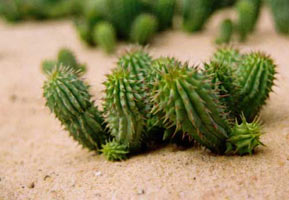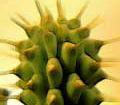
Hoodia gordonii, "Whoo De AH", is the botanical name for a leafless, spiky succulent plant that grows throughout the semi-arid areas of Southern Africa primarily the Kalahari desert. The San (local inhabitants) have rationally used Hoodia stems to stave off hunger and thirst when on long journeys, as it acts as an appetite suppressant. Hoodia Gordonii was discovered and used by the San tribe from the Kalahari, South Africa, since prehistoric times. They chewed the bitter Hoodia plant twice a day to suppress hunger and thirst during long hunting trips. This plant contains the miracle molecule p57 that was recently translated into a obesity cure. Hoodia Gordonii is a leafless spiny succulent plant ( not a cactus ) with fleshly finger-like stems. Rows of thorns are present along the stems, bearing flesh coloured flowers. Hoodia Gordonii grows naturally in the harsh desert conditions of South Africa. Now Hoodia Gordonii has been found in the semi-deserts of Zambia, Zimbabwe, Botswana, Namibia, Angola, the Republic of South Africa, and now found in some other arid regions of South American Nations such as Chili, Peru and some regions of West China including Gansu, Sichuan and Shanxi.
After years of careful research, scientists isolated several compounds in this all-natural food that was responsible for dramatic weight loss, P57, which has been widely reported, is but one of several chemical compounds found in the Hoodia succulent. Not only was it proven completely safe, it contains no stimulates that could contribute to the jittery feeling associated with weight loss products of the last decade. Mass global interest has been shown for Hoodia since Pfizer, the international pharmaceutical giant, started to research Hoodia's potential to help people with obesity. Pfizer recently discovered Hoodia and decided to invest millions into researching the plants benefits as a new drug that would help with obesity. The research published by this company has catapulted Hoodia into the international spotlight. Laboratory experiments show animals automatically restrict their food intake when taking hoodia orally. Rats, a species that will eat anything from meat and plants to indigestible fiber, lowered their dietary calorie intake to a degree that made them get thin when fed comparative amounts of hoodia.
The pure Hoodia that contains appetite suppressant qualities is only grown in one specific region in South Africa. If the Hoodia is from China, USA or any other part of the world and is not accompanied by a South African Government Certificate of Authenticity, the product is inferior and ineffective. All over the world, people are trying to buy hoodia, and there just isn't enough supply to go around. The succulent growers have been wiped out. The seed providers have virtually no inventory left. And since hoodia takes more than six years to grow to harvesting height, there's going to continue to be a great hoodia shortage until at least 2010, maybe beyond. So buying hoodia is very difficult. It's expensive. And, naturally, there are a lot of fakes on the market. Even now, there are only a few hundred acres of hoodia growing on commercial farms, and the plant is highly susceptible to being wiped out by rather mysterious conditions. All this means that if hoodia really catches on with the public -- the supply will be even tighter for many years. Prices are going to go up, and eventually, only the wealthy may be able to afford the pills necessary to lose weight.

|